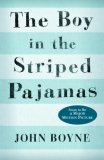Summary | Excerpt | Reading Guide | Reviews | Beyond the Book | Read-Alikes | Genres & Themes | Author Bio

Critics' Opinion:
Readers' Opinion:
First Published:
Sep 2006, 224 pages
Paperback:
Oct 2007, 240 pages
 Book Reviewed by:
Book Reviewed by:
BookBrowse Review Team
Buy This Book
This article relates to The Boy in the Striped Pajamas
Auschwitz was the name the Germans used for the Polish city of Oswiecim when they occupied it in WWII. The concentration camp was established nearby in June 1940, taking the name of the nearby town. The camp quickly expanded into three main parts: Auschwitz I, Auschwitz II-Birkenau, and Auschwitz III-Monowitz - a group of about 40 sub-camps. In 1942, when the mass exterminations began, the camps (the largest complex of extermination camps in the Reich) became the site of the greatest mass murder in the history of humanity, with the majority of the arrivals being gassed on arrival in the Birkenau gas chambers.
Between 1.1 to 1.6 million people were killed there, about 90% were Jews, plus many Poles, Soviet prisoners-of-war and Roma (gypsies).
Auschwitz I was the administrative center and housed between 13,000 to 16,000 inmates at anyone time, rising to 20,000 in 1942. In September 1941 the SS started to experiment with poison gas on prisoners in Auschwitz I. Auschwitz I is also where Dr Carl Clauberg conducted his sterilization experiments on women (primarily involving injecting caustic chemicals into their uteruses) and Dr Josef Mengele carried out his well-known experiments; it also housed the camp brothel used to reward privileged prisoners, and also used by the Nazis.
More than 1 million were killed in Auschwitz II's four gas chambers, designed to look like showers, and burned in its four crematoria.
About 40 satellite camps were established around the two main camps to provide forced labor, they were collectively known as Auschwitz III.
Once the mass exterminations began, the prisoners were sorted on arrival. Within a few hours of arrival, all children, women with children, elderly and sick were gassed at a rate of 20,000 a day. Others were assigned to slave labor (340,000 of the 405,000 prisoners recorded as slaves died). Some, mostly twins and dwarfs went for medical experiments; and some, mainly women, were assigned to sort prisoners' belongings.
At the end of the war,the SS, in an effort to cover up their crimes, began to dismantle the buildings and "evacuated" any prisoners capable of marching into the heart of the Reich. About 56,000 prisoners were marched out of the camps in January 1945 under heavy escort, with many dying during the evacuation that became known as the Death March. The remaining 7,600 prisoners were liberated by Soviet soldiers a few days later. In 1947 the Polish parliament established the Auschwitz-Birkenau State Museum on the grounds of Auschwitz I and Auschwitz II-Birkenau.
Filed under Places, Cultures & Identities
![]() This "beyond the book article" relates to The Boy in the Striped Pajamas. It originally ran in September 2006 and has been updated for the
October 2007 paperback edition.
Go to magazine.
This "beyond the book article" relates to The Boy in the Striped Pajamas. It originally ran in September 2006 and has been updated for the
October 2007 paperback edition.
Go to magazine.





The House on Biscayne Bay
by Chanel Cleeton
As death stalks a gothic mansion in Miami, the lives of two women intertwine as the past and present collide.

The Flower Sisters
by Michelle Collins Anderson
From the new Fannie Flagg of the Ozarks, a richly-woven story of family, forgiveness, and reinvention.

The Funeral Cryer by Wenyan Lu
Debut novelist Wenyan Lu brings us this witty yet profound story about one woman's midlife reawakening in contemporary rural China.
Your guide toexceptional books
BookBrowse seeks out and recommends the best in contemporary fiction and nonfiction—books that not only engage and entertain but also deepen our understanding of ourselves and the world around us.